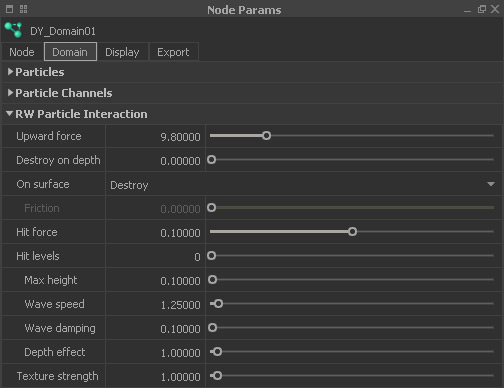DyDomain - RW Particle Interaction
"RW Particle Interaction" is responsible for the particles' interaction with a RealWave surface. Secondary waves and ripples are created by a particle’s hit force.
Upward force
Particles below the water surface always try to move in the direction of the surface and counteract gravity.
Destroy on depth
Particles that reach the entered depth will be deleted. This value strongly depends on the wave modifier you use and the final wave height.
On surface
You can choose from three options:
- “No interact” makes the particle fall through the RealWave surface where they can be deleted with a "k Volume" daemon.
- “Destroy” automatically removes the particles when they hit the surface.
- “Place” makes the particles float on the surface. To avoid accumulations between the wave crests you can delete the particles with a "k Age" daemon.
Friction
This parameter is only available when "On surface" is set to "Place". You can adjust the particles' friction to make them stay closer to the object for a longer time.
Split
With this option, RealFlow creates additional particles when a certain condition is fulfilled, e.g. when a particle interacts with the RealWave surface.
# child
Here you can determine the number of children that will be generated from each particle when “Split” is set to “Yes”.
Hit force
If you need stronger ripples increase “Hit force”. Large “Hit force” settings in combination with high “Wave speed” values can lead to unwanted high-frequency patterns.
Hit levels
This mode can be seen as a "radius of action". With increasing values more and more vertices around the particle's impact zone will be disturbed. High values will slow down the simulation and affect very large parts of the surface leading to an unnatural look. "Hit levels" should not be greater than 5.
Max height
The value represents the maximum height of the particles' impact waves given in metres.
Wave speed
The speed of the secondary ripples can be restricted, because high velocities might lead to unwanted spikes and high-frequency effects.
Wave damping
To prevent the particle-induced waves from endless propagation, you can limit their life-span. The waves will disappear smoothly.
Depth effect
In real life, objects can create waves when moving below the surface at a shallow depth. This parameter sets the depth limit at which any object will affect the surface.
Texture strength
Particles that interact with a RealWave surface can be used to create foam maps. If you can hardly see the particle marks on these textures we advise you to either raise this value and/or the domain's “Resolution” parameter. To achieve a less distinctive effect, values smaller than 1.0 should be considered.
